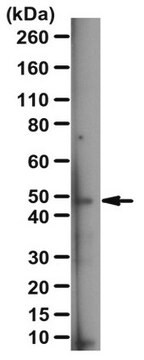790146P
Avanti
16:0-23:2 Diyne PC
1-palmitoyl-2-(10,12-tricosadiynoyl)-sn-glycero-3-phosphocholine, powder
Synonym(e):
PTPC
Anmeldenzur Ansicht organisationsspezifischer und vertraglich vereinbarter Preise
Alle Fotos(1)
About This Item
Empirische Formel (Hill-System):
C47H86NO8P
CAS-Nummer:
Molekulargewicht:
824.16
MDL-Nummer:
UNSPSC-Code:
12352211
NACRES:
NA.25
Empfohlene Produkte
Assay
>99% (TLC)
Form
powder
Verpackung
pkg of 1 × 25 mg (790146P-25mg)
Hersteller/Markenname
Avanti Research™ - A Croda Brand 790146P
Versandbedingung
dry ice
Lagertemp.
−20°C
Anwendung
16:0-23:2 Diyne PC or 1-palmitoyl-2-(10,12-tricosadiynoyl)-sn-glycero-3-phosphocholine has been used in lipid-monolayer interface of nanoparticles (NPs) to modify the drug diffusion across the layer.
Biochem./physiol. Wirkung
16:0-23:2 Diyne PC or 1-palmitoyl-2-(10,12-tricosadiynoyl)-sn-glycero-3-phosphocholine (PTPC) is a polymerizable lipid that can cross-link with adjacent PTPC molecules under ultraviolet light (UV)-irradiation.
Verpackung
5 mL Amber Glass Screw Cap Vial (790146P-25mg)
Rechtliche Hinweise
Avanti Research is a trademark of Avanti Polar Lipids, LLC
Lagerklassenschlüssel
11 - Combustible Solids
Hier finden Sie alle aktuellen Versionen:
Analysenzertifikate (COA)
Lot/Batch Number
It looks like we've run into a problem, but you can still download Certificates of Analysis from our Dokumente section.
Wenn Sie Hilfe benötigen, wenden Sie sich bitte an Kundensupport
Besitzen Sie dieses Produkt bereits?
In der Dokumentenbibliothek finden Sie die Dokumentation zu den Produkten, die Sie kürzlich erworben haben.
Esther Shohami et al.
British journal of pharmacology, 163(7), 1402-1410 (2011-03-23)
Traumatic brain injury (TBI) represents the leading cause of death in young individuals. It triggers the accumulation of harmful mediators, leading to secondary damage, yet protective mechanisms are also set in motion. The endocannabinoid (eCB) system consists of ligands, such
S Punnamaraju et al.
Langmuir : the ACS journal of surfaces and colloids, 28(20), 7657-7664 (2012-05-03)
A combination of nonpolymerizable phospholipids (DPPC or DPhPC) and a smaller amount of cross-linking photopolymerizable phospholipids (23:2 DiynePC) is incorporated in an unsupported artificial lipid bilayer formed using the droplet interface bilayer (DIB) approach. The DIB is formed by contacting
Unser Team von Wissenschaftlern verfügt über Erfahrung in allen Forschungsbereichen einschließlich Life Science, Materialwissenschaften, chemischer Synthese, Chromatographie, Analytik und vielen mehr..
Setzen Sie sich mit dem technischen Dienst in Verbindung.
![23:2 Diyne PC [DC(8,9)PC] Avanti Research™ - A Croda Brand 870016P, powder](/deepweb/assets/sigmaaldrich/product/structures/284/664/e58cb25d-e85d-46ca-80f2-870cae07c7f5/640/e58cb25d-e85d-46ca-80f2-870cae07c7f5.png)






![23:2 Diyne PE [DC(8,9)PE] 1,2-bis(10,12-tricosadiynoyl)-sn-glycero-3-phosphoethanolamine, powder](/deepweb/assets/sigmaaldrich/product/images/228/422/4e95f75c-14fa-4117-a383-2eff73fa927f/640/4e95f75c-14fa-4117-a383-2eff73fa927f.jpg)
